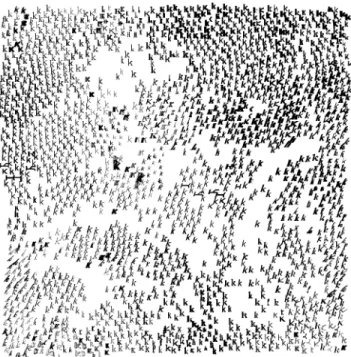The Universe of Fonts, Charted by Machine
J¨orn Loviscach
∗Fachhochschule Bielefeld (University of Applied Sciences)
1 Introduction
Today, computer fonts come in hundreds and thousands. How do you find a font that fits for the task at hand? Which general types are available? Which ones are related—or not related at all—to the ones you know well? To address such issues, this work applies strategies from Music Information Retrieval (MIR) to organizing fonts. Finding similar music and graphically laying out a music collection according to the similarity of the tracks are standard tasks in MIR, tackled by automatically extracting meaningful but low- level descriptors from the bare content data—that is: waveforms—
and discovering high-level meaning through machine learning.
In the same spirit, this work introduces a set of descriptors to be extracted from the font files. These descriptors are used to create a two-dimensional layout of fonts according to their similarity, see Figure 1. This readily shows duplicates and clones as well as clus- ters. It also enables a serendipitous approach for finding fonts that are in some surprising respect similar to a given font.
2 Font Similarity and Charting
The software prototype fetches the outline curves of all installed fonts and computes six descriptors for each character. These are averaged according to the characters’ frequency in a given text file.
Apparent Height. The maximum height is divided in 1000 bins.
Each character’s area in each height bin is computed to create a height histogram. The “apparent height” is taken to be the 95
thper- centile minus the 10
thpercentile of this histogram, which reliably removes descenders and spuriously tall special characters. The ap- parent height is not used directly for similarity computations, but helps to normalize other parameters since fonts of nominally equal size come at wildly differing apparent sizes.
Weight. Each character’s area is divided by the square of the arc length of its contour. This is independent of the overall size, equals 1/4π for a circle, and tends to zero as the shape gets more meager.
Roundness. A histogram of the slopes that occur in the outlines is computed by stepping along the contours, weighting by the steps’
arc lengths. A low entropy of this histogram means that some direc- tions are strongly favored. Rounded fonts possess a high entropy.
Slant. To suppress near-horizontal directions, the same histogram is weighted with the sine of the slope angle. Then, the mean value of the cosine of the angle is computed, which is zero for upright lines and positive for forward-slanted lines. The mean value is con- verted back to an angle by taking the arc cosine. The resulting angle characterizes the font outline’s mean non-horizontal direction.
Curvature. To compute a robust measure of the local curvature such as serifs or grunge-style font features, a pair of points is swept along all contours. Measured along the curve, these two points have a distance of 0.05 times the apparent font height (which is to be computed beforehand, as described above). Then the triangle is considered that is formed by this pair of points and by the point on the contour that sits at their middle in terms of arc length. The ratio of the height of the middle point in this triangle to the apparent font
∗
